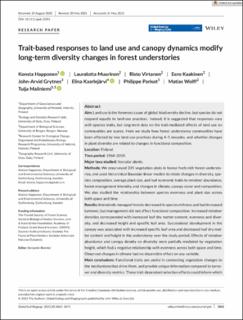| dc.contributor.author | Happonen, Konsta | |
| dc.contributor.author | Muurinen, Lauralotta | |
| dc.contributor.author | Virtanen, Risto | |
| dc.contributor.author | Kaakinen, Eero | |
| dc.contributor.author | Grytnes, John Arvid | |
| dc.contributor.author | Kaarlejärvi, Elina | |
| dc.contributor.author | Parisot, Philippe | |
| dc.contributor.author | Wolff, Matias | |
| dc.contributor.author | Maliniemi, Tuija | |
| dc.date.accessioned | 2021-09-10T12:26:07Z | |
| dc.date.available | 2021-09-10T12:26:07Z | |
| dc.date.created | 2021-09-09T09:41:06Z | |
| dc.date.issued | 2021 | |
| dc.identifier.issn | 1466-822X | |
| dc.identifier.uri | https://hdl.handle.net/11250/2775240 | |
| dc.description.abstract | Aim: Land use is the foremost cause of global biodiversity decline, but species do not respond equally to land-use practices. Instead, it is suggested that responses vary with species traits, but long-term data on the trait-mediated effects of land use on communities are scarce. Here we study how forest understorey communities have been affected by two land-use practices during 4–5 decades, and whether changes in plant diversity are related to changes in functional composition.
Location: Finland.
Time period: 1968–2019.
Major taxa studied: Vascular plants.
Methods: We resurveyed 245 vegetation plots in boreal herb-rich forest understories, and used hierarchical Bayesian linear models to relate changes in diversity, species composition, average plant size, and leaf economic traits to reindeer abundance, forest management intensity, and changes in climate, canopy cover and composition. We also studied the relationship between species evenness and plant size across both space and time.
Results: Intensively managed forests decreased in species richness and had increased turnover, but management did not affect functional composition. Increased reindeer densities corresponded with increased leaf dry matter content, evenness and diversity, and decreased height and specific leaf area. Successional development in the canopy was associated with increased specific leaf area and decreased leaf dry matter content and height in the understorey over the study period. Effects of reindeer abundance and canopy density on diversity were partially mediated by vegetation height, which had a negative relationship with evenness across both space and time. Observed changes in climate had no discernible effect on any variable.
Main conclusions: Functional traits are useful in connecting vegetation changes to the mechanisms that drive them, and provide unique information compared to turnover and diversity metrics. These trait-dependent selection effects could inform which species benefit and which suffer from land-use changes and explain observed biodiversity changes under global change. | en_US |
| dc.language.iso | eng | en_US |
| dc.publisher | Wiley | en_US |
| dc.rights | Navngivelse 4.0 Internasjonal | * |
| dc.rights.uri | http://creativecommons.org/licenses/by/4.0/deed.no | * |
| dc.title | Trait-based responses to land use and canopy dynamics modify long-term diversity changes in forest understories | en_US |
| dc.type | Journal article | en_US |
| dc.type | Peer reviewed | en_US |
| dc.description.version | publishedVersion | en_US |
| dc.rights.holder | Copyright 2021 the authors | en_US |
| cristin.ispublished | true | |
| cristin.fulltext | original | |
| cristin.qualitycode | 2 | |
| dc.identifier.doi | https://doi.org/10.1111/geb.13351 | |
| dc.identifier.cristin | 1932680 | |
| dc.source.journal | Global Ecology and Biogeography | en_US |
| dc.source.pagenumber | 1863-1875 | en_US |
| dc.identifier.citation | Global Ecology and Biogeography. 2021, 30 (9), 1863-1875. | en_US |
| dc.source.volume | 30 | en_US |
| dc.source.issue | 9 | en_US |

